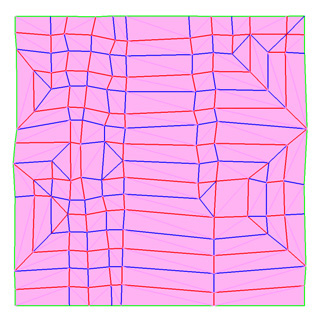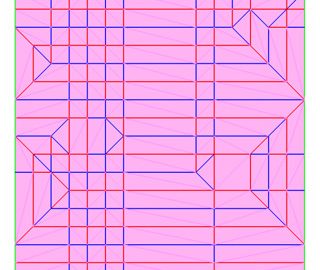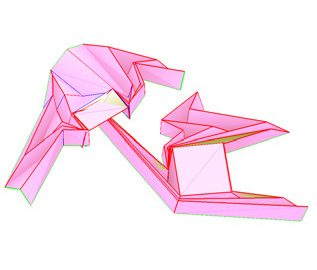“Smooth origami animation by crease line adjustment” by Tachi
Conference:
Type(s):
Title:
- Smooth origami animation by crease line adjustment
Presenter(s)/Author(s):
Abstract:
A folding process of simple origami can be represented by a sequence of simple folding processes [Miyazaki et al. 1996], but this method cannot be applied for complex origami models because the folds in a complex model are constrained around vertices and not independent of each other. Hence the rigid origami model that represents origami as plates connected by hinges is suitable for complex origami models. Balkcom [2002] shows a way for calculating rigid origami kinematics. This model has two problems, lack of degrees of freedom and a singularity problem that some of the crease lines cannot begin to be folded until other crease lines are completely folded flat. We propose a method for making a smooth and comprehensible origami animation by avoiding above-mentioned problems by adding and adjusting the crease lines on an origami model. The overall folding process is constructed from crease line pattern.
References:
1. Balkcom, D. 2002. Robotic Origami Folding. PhD thesis, Carnegie Mellon University.
2. Belcastro, S. M. and Hull, T. C. 2002. A Mathematical Model for Non-Flat Origami. In Proceedings of the 3rd International Meeting of Origami Mathematics, Science and Education, 39–52.
3. Miyazaki, S., Yasuda, T., Yokoi, S., and Toriwaki, J. 1996. An Origami Playing Simulator in the Virtual Space. The Journal of Visualization and Computer Animation, 7, 1, 25–42.
Additional Images:
- 2006 Poster: Tachi_Smooth Origami Animation by Crease Line Adjustment
- 2006 Poster: Tachi_Smooth Origami Animation by Crease Line Adjustment








